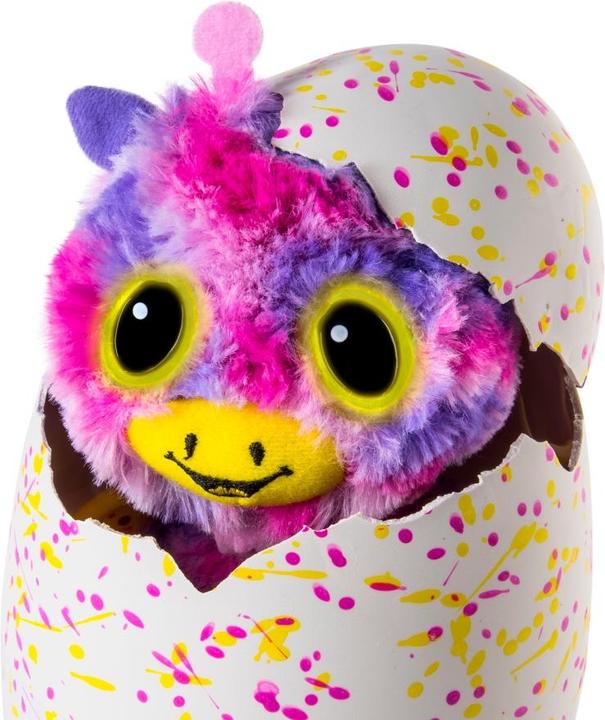
Hatchimals – there’s something hatching
What’s hiding in this egg? A Hatchimal. But you’ll only find out which one it is when it hatches. Once your new «pet» is here, you’ll get to watch it go through all the phases of development. As the Hatchimal grows up before your eyes, it will be keen to learn as much as it can from you, its owner.
This new Hatchimal egg is home to two very similar magical beings. Twins, to be more precise. Their names give you a clue about the type of hybrid creature they are. «Giraven» is a mixture of giraffe and raven. But if you ask me, these little bundles of joy also look a bit like dinosaurs or baby dragons.

Birth
To encourage the egg to hatch, you first have to remove both locking pins on the base of the egg. It’s a good idea to dispose of these pins or set them aside straight away, as they’re relatively small and can easily be swallowed by a child.
Now the egg needs your help. Keep a firm grasp on the base so the Hatchimal inside doesn’t freeze. This marks the start of the hatching process starts. While all this is going on, you’ll notice the egg keeps changing colour. The shade the shell finally settles on dictates the type of needs your Hatchimal will have – and which you’ll have to satisfy.
The instructions contain a table that shows what each colour means and what you have to do. For instance, red signifies that the Hatchimal is sad. To make it feel better again, you need to rub the bottom of the egg. Meanwhile, a flashing orange light is a sign that the little creature has hiccups. Tapping on the egg will help to ease them. Normally, it takes 15 to 20 minutes before you notice the results.

Once you see a pair of rainbow-coloured eyes inside the egg, it’s ready to hatch. Rub the bottom of the egg so the Hatchimal starts pushing the shell from the inside. All the while, the egg should be white. Rub the bottom of the egg until the Hatchimal has managed to peck itself free. Now you can remove the top of the shell and lift your Hatchimal out of the egg. There should still be plastic wrapping around the wings. Remove this and then press your Hatchimal on the nose. As soon as the Hatchimal has sung «Hatchi Birthday», it’s ready to play.
Growing up
Once the Hatchimals have hatched from their eggs, they go through various phases of learning. They grow from baby to toddler and then child. In each phase, they learn new movements and commands. Whenever they complete a phase, their eyes flash rainbow colours and they sing «Hatchi Birthday».
Baby
In the baby phase, it’s all about affection. You have to look after your Hatchimal and bring it up. At this time, the Hatchimal will want to be pampered and cared for. Its eyes can also light up in different colours to indicate specific needs. As with the egg, there is a table in the instructions that explains what each of the colours means and how you should react.
You can interact with the Hatchimal while it’s still a newborn by feeding, cuddling, soothing and tickling it. You stroke its head, press its stomach or tilt it forward depending on its behaviour.
Toddler
When the Hatchimal is a toddler, it still has a great joy for learning. You can teach it to walk, speak and even dance. Thanks to the inbuilt microphone, the Hatchimal can hear what you say and then repeat it. As far as I’m aware, it’s still not able to memorise what you tell it. Given data protection, this is probably a sensible decision.
As for teaching the little one to walk, all you need to do is clap your hands. Clapping once means you want it to walk forwards. Clapping several times or more makes the Hatchimal turn in a circle. But make sure it doesn’t get dizzy. You can obviously still play the same games with your Hatchimal as you did in the previous phase.
Child
Your Hatchimal toddler has now developed into a child. It has already learnt everything and anything it possibly could, and now it wants to play. There are four different playing modes. You can play catch with your little rascal and/or use its fortune teller feature. This lets you ask your Hatchimal a question that can be answered with yes or no. It then answers or emits a noise.

Verdict
As you’re around for most of the stages in the Hatchimal’s growth, you’ll find you develop a bond with the toy. You feel like you’re responsible for another being and for looking after it. While this can be a pleasant experience, it’s also a bit creepy. I personally find the Hatchimals sweet and cuddly. And the handy thing is, they’re suitable for both girls and boys.
In terms of cost, I think the Hatchimals are priced fairly, given the number of hours of fun you’ll get playing with them. I certainly think a Hatchimal would make a great gift for under the Christmas tree.
Don’t worry if the pink-yellow egg isn’t to your taste. It’s also available in purple-green. Just remember that the Hatchimals from that kind of egg look a bit different:
Riding my motorbike makes me feel free, fishing brings out my inner hunter, using my camera gets me creative. I make my money messing around with toys all day.
